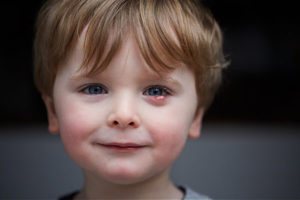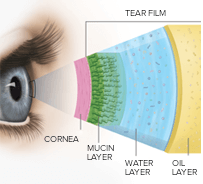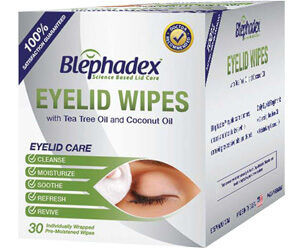Blepharitis (inflammation of the eyelids) and meibomitis (inflammation of oil glands along the eyelid margins) are usually chronic conditions that may fluctuate in severity.
Signs encompass crustiness, flakiness, or greasiness at the base of the lashes and red and swollen eyelid margins which may stick together.
Patients may experience burning, grittiness, light sensitivity, irritation, contact lens intolerance, excessive tearing, and blurry vision—all symptoms of dry eyes—which can be caused by these conditions.
 A chalazion is caused by an obstructed oil gland in the eyelid, not by an infection, although it can become secondarily infected.
A chalazion is caused by an obstructed oil gland in the eyelid, not by an infection, although it can become secondarily infected.
There are approximately 30 meibomian glands per eyelid, so if multiple meibomian glands become clogged, more than one chalazion can occur per eyelid.
BLEPHARITIS SECONDARY TO DEMODEX MITES
Demodex mites can cause blepharitis with symptoms of ocular itching, irritation, burning, foreign body sensation, and blurry vision. Signs include sleeves of tissue surrounding the base of the mite-infested lashes, scaly skin, and threadlike, wavy vessels on the lid margin.
Demodex folliculorum mites live in lash follicles. Demodex brevis mites invade meibomian and sebaceous glands and cause meibomian gland dysfunction and evaporative dry eye. Mites emerge at night to mate. They dislike light and are sensitive to heat.
ASSOCIATION OF BLEPHARITIS WITH DRY EYES
 Patients with blepharitis often have associated dry eyes because they deficiently secrete lipids from their meibomian glands into their tear film.
Patients with blepharitis often have associated dry eyes because they deficiently secrete lipids from their meibomian glands into their tear film.
Tears are composed of an inner mucin layer close to the cornea (window of the eye) for even spreading, a middle water layer with moisture and proteins for resistance to infection, and an outer oil (lipid) layer to seal the tear film.
Thus, treating blepharitis and meibomitis, eyelid conditions which characteristically have deficient secretion of oil from the meibomian glands, can yield significant relief of dry eyes.
Taking re-esterified omega-3 fatty acid supplements in fish oil or flaxseed oil (1-3g two to three times daily by mouth per day (to achieve a therapeutic effect) helps retard the evaporation of tears because omega-3 fatty acids soften lipids in the meibomian glands of the eyelids and improve their release of lipids to the outer tear film layer.
Blepharitis, Meibomitis & Chalazia Treatment
CONSERVATIVE

- Warm compresses,
- Lid hygiene (with Blephadex wipes which are saturated with a combination of tea tree oil and coconut oil), massage, and
- Topical and/or systemic medication may help reduce blepharitis, meibomitis, and chalazia.
- Artificial tears can help alleviate symptoms of meibomitis and blepharitis, since the conditions may also cause dry eyes.
- Supplementation with omega-3 fatty acids (EPA, DHA, and ALA) in fish oil (EPA and DHA) and flaxseed oil (ALA), and systemic clarithromycin or azithromycin may be beneficial because they all soften oil in meibomian glands and improve secretion.
- Punctal plug insertion, or in severe cases, punctal cautery can also be considered.
- The incidence of demodex blepharitis may be decreased by removing makeup before sleeping and by avoiding sleeping with pets. Demodex infestation may need to be treated over a couple of cycles (especially for demodex brevis) with diluted tea tree oil and the antibiotic ivermectin.
SURGICAL
Dr. Shin removes the chalazion(ia) in an ambulatory surgery center. The child receives general anesthesia and is asleep for the entire procedure. An anesthesiologist monitors the child and ensures that the child does not feel any discomfort or pain during the procedure.
Most incisions are made on the underside of the eyelid. The inflamed tissue is removed with a sterile surgical instrument.
In cases with a skin incision, dissolvable sutures and/or tissue glue may be used. An antibiotic ointment will be applied to the eye or eyelid skin if it does not have tissue glue for a week after the procedure.









